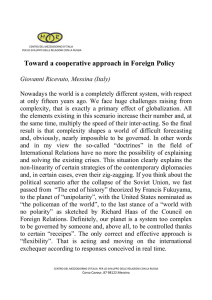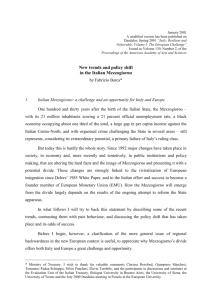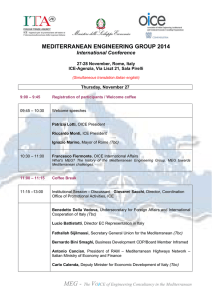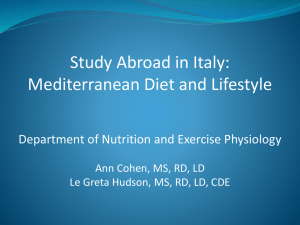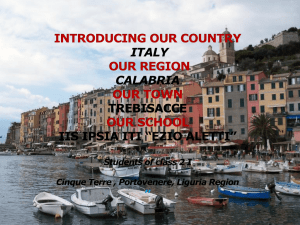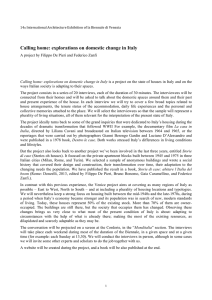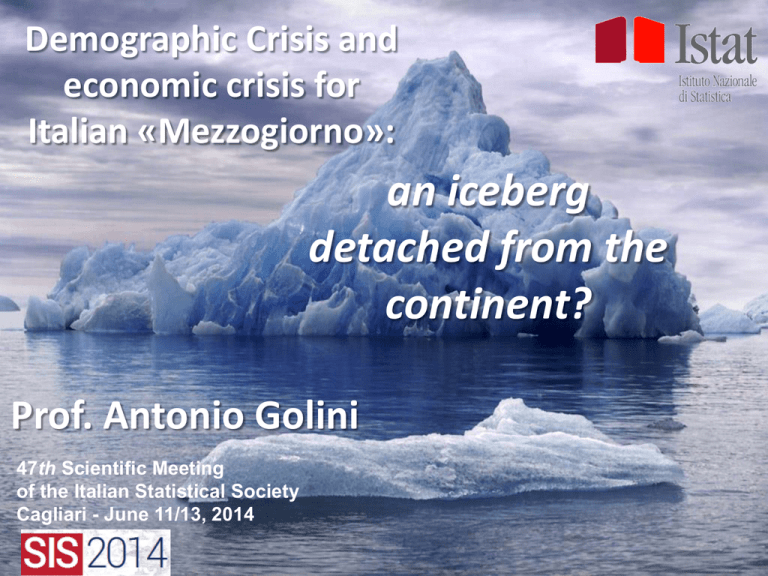
Demographic Crisis and
economic crisis for
Italian «Mezzogiorno»:
an iceberg
detached from the
continent?
Prof. Antonio Golini
47th Scientific Meeting
of the Italian Statistical Society
Cagliari - June 11/13, 2014
THE ITALIAN ECONOMIC FRAMEWORK \1
The Italian economy has
been
dramatically
affected
by
the
deterioration
of
the
global economy, and by
the negative impact of
the
financial
and
sovereign debt crisis.
Saving propension (right)
Consumption
Gross available income
UE public debt (2012) (% of the GDP)
Source: ISTAT
Turnover by destination market
THE ITALIAN ECONOMIC FRAMEWORK \2
The severity of the tax measures;
the structural and conjuntural
difficulties of the Labour market;
the decline in the purchasing
power of households;
the weakness of the economic
internal and external demand; the
strong uncertainty about
the
prospects for growth, have led to a
worrying socio-economic decay in
all the Italian geographic areas.
% variation of expenditure
Expenditure for
final consumption
and gross available
income
(1995-2013)
(billions of euro)
% variation of purchasing power
Source: ISTAT
«MEZZOGIORNO»:
AN ICEBERG DETACHED FROM THE CONTINENT?
This paralyzed and confused
economic framework, which
affects the entire national
territory, stands out with an
exponential
intensity
and
pervasiveness in the South of
Italy (“Mezzogiorno”),
which both as far as key indicators of the
labour market and of the socio-economic
conditions are concerned, represents
the “statistics queue” of the Italian
breathless society and economy.
Employment rate by geographic areas, sex, age (2008-2013) (%)
Source: EUROSTAT, LFS
«MEZZOGIORNO»:
AN ECONOMIC, DEMOGRAPHIC AND POLITIC ICEBERG \1
Employment rate (15-64) variation (2013 - %)
Employment rate 2013 (15-64); variation 2006-2013
(Europe Countries and italian geographical areas)
Employment rate (15-64) variation (2006-2013)
The «Mezzogiorno» shows the lowest employment rate (27,6%)
Source: ISTAT
«MEZZOGIORNO»:
AN ECONOMIC, DEMOGRAPHIC AND POLITIC ICEBERG \2
An emerging and abiding demographic crisis has to be added to the
economic and financial crisis because of decreasing fertility rates and a
quick and intensive ageing process.
Center-North
Male
Mezzogiorno
Female
Source: ISTAT
Male
Female
«MEZZOGIORNO»:
AN ECONOMIC, DEMOGRAPHIC AND POLITIC ICEBERG \3
the “Mezzogiorno Iceberg” is also
expected to carry back the other
European countries, if considered
not more than a national or local
question
between
southern
regions:
but without European shared
strategies of social and economic
development, starting from the
“fall of the Mediterranean Wall” –
which is the new fatal barrier
between well-being and socioeconomic backwardness – an
asphyxiated
doom
would
progressively involve all the
European countries like an
imploding domino.
The Union for the
Mediterranean and
afterwards a EuroAfrican Union could
politically
and
economically
be
the
saving
solution?
1.
MEZZOGIORNO
ECONOMIC CRISIS
and
LIVING CONDITIONS
«MEZZOGIORNO»:
AN ECONOMIC, DEMOGRAPHIC AND POLITIC ICEBERG \1
In 2013 Italy the unemployment rate has reached the 12,2% (+5,4 pp. from 2008). The
increasing has particularly involved the Mezzogiorno (+7,7 pp), where the indicator has
reached a value of 19,7%, being the worst after Greace and Spain.
Unemployment rate (2013 - %)
Source: EUROSTAT, LFS
«MEZZOGIORNO»:
AN ECONOMIC, DEMOGRAPHIC AND POLITIC ICEBERG \2
Geographical differences are strongly evident even with an equal education.
Education is particularly crucial for female participation in the labor market.
Employment rate (30-34), by sex, geographical area and education (2013 - %)
MALE
FEMALE
Source: ISTAT
«MEZZOGIORNO»:
AN ECONOMIC, DEMOGRAPHIC AND POLITIC ICEBERG \3
Rate of «non participation» (2008-2013 )
Rate of «non participation» 2013 )
Definitely
crucial
also
the
huge
territorial gap in the
rate
of
nonparticipation.
Variation 2008-2013 in pp. - Rate of «non participation»
Source: ISTAT
«MEZZOGIORNO»:
AN ECONOMIC, DEMOGRAPHIC AND POLITIC ICEBERG \4
The growth of “Neet” highlights
the escalation of difficulties in
entering the Labour market.
The presence of a large unused
"young" labor supply is particularly
severe in the Mezzogiorno and among
women.
NEET (15-29)
Source: ISTAT
«MEZZOGIORNO»:
AN ECONOMIC, DEMOGRAPHIC AND POLITIC ICEBERG \5
ABSOLUTE POVERTY (2007-2012) (%)
Geographical
areas
PERSONS WHO LIVE IN FAMILIES WITH SEVERE DEPRIVATIONS
(2007-2013) (%)
Source: ISTAT
«MEZZOGIORNO»:
AN ECONOMIC, DEMOGRAPHIC AND POLITIC ICEBERG \6
Per capita expenditure on social services and
assistance of the municipalities (2011)
Source: ISTAT
«MEZZOGIORNO»:
AN ECONOMIC, DEMOGRAPHIC AND POLITIC ICEBERG \7
Absence of social and environmental decay
Difficult access to services
Easy access to services
High degree of
confidence
social and environmental decay
Source: ISTAT
Low/absent degree
of confidence
2.
MEZZOGIORNO
and
DEMOGRAPHIC CRISIS
MEZZOGIORNO AND THE «GENDER REVOLUTION»
The “Mezzogiorno” of Italy is passing through a deep demographic
revolution, pivoting on a “gender revolution” based on women’s
emancipation from the “patriarchal culture”.
The second demograhic transition has been determined and crossed by a
deep and radical
recontractualisation and
reorganisation
individual and collective, cultural and economic,
of individual transitions during the life cycle;
of gender identities, relations and roles;
This evolutione/revolution of demo-social and economic-cultural structures
and dynamics strictly interacts with reproductive choices, impacting on
possibility and calendar of life transitions.
* M.L. Boccia, G. Zuffa, L’eclissi della madre. Fecondazione artificiale, tecniche, fantasie e norme. Pratiche editrici, Milano, 1998
BIRTHS POSTICIPATION AND THE “DEMOGRAPHIC RESHAPING”
The Italian “Mezzogiorno” is experimenting its “demographic reshaping” in a
national “demographic reshaping”.
In fact, the phenomenon of births
posticipation has been reshaping our
country since ’70.
Maternity has been the more and
more pushed towards advanced
ages.
Age specific fertility rates of women
living in Italy. 1970 and 2007, values
for 1.000 women
«Women’s
freedom area»
Source: Eurostat (2011) e UN Statistical Division (2012)
TOTAL FERTILITY RATE (R)EVOLUTION:
A DEMOGRAPHIC «MARIANA TRENCH»?
TFT – Italy (1952-2012)
SUBSTITUTION LEVEL: 2,1
1977: TFR turning point
Fonte: ISTAT, Demo.istat e I.STAT
POSTICIPATION AND BIRTHS CONTRACTION
Between 1970 and 1990, Italy has been
characterised by births posticipation and fertility
contraction.
The following weak increasing has been
determined by baby-boomers, and by mothers
with more than 35 years.
Nevertheless, the Mezzogiorno has been
characterised by negative variations also between
1995 and 2008.
Women’s empowerment has determined
an incredible overturning of the fertility
rate: the South of Italy, which was the
geographic area with the highest fertility
rate in Italy, nowadays is characterized by
the lowest fertility rate, also for a lack of
births from foreign women.
% VARIATION BIRTHS BY REGIONS.
(1995-2008 AND 2008-2012)
1995-2008
Source: ISTAT
2008-2012
A DECLINING MEZZOGIORNO…
Total fertility rate. 1995-2011
Source: ISTAT
… AND THE INCREDIBLE SARDINIA:
FROM YOUNGEST REGION TO THE OLDEST ONE
Source: ISTAT, Demo.istat and I.STAT
LIVING LESS, SURVIVING WORST:
THE DOUBLE WEAKNESS OF ”MEZZOGIORNO”
MALE
GOOD
HEALTH
FEMALE
NOT GOOD
HEALTH
GOOD HEALTH
Physical state
Persons wo live in the North of Italy have a
higher life expactancy and a better quality
of life.
Moreover, the Mezzogiorno of Italy has
also very low scores both as far as the
physical and psychological wellness are
concerned.
Source: ISTAT - BES
NOT GOOD
HEALTH
Psychological state
NOT PREPARED TO FACE THE AGEING PROCESS
Consequently, the South of Italy is
dramatically involved in the ageing
process, but without being ready to
face the planetary challenge of
ageing:
Nevertheless,
which
kind
of
continental, national and regional
substantial economic and political
supports can be reported?
Aged
Men
and
female
from
Mezzogiorno have
the
lowest
life
expectancy without
limitations in the
daily life.
Source: ISTAT
UNSUFFICIENT ASSISTANCE FOR THE ELDERLY
per capita spending on social services and assistance
for the elderly (2011)
Source: ISTAT
3.
MEZZOGIORNO
and
POLITICAL CRISIS
MEDITERRANEAN SEA:
WHEN «WALLS» BECOME HORIZONTAL
THE MEDITERRANEAN SEA
IS THE NEW «WALL”:
The «wall»
between wellbeing and poverty,
between democracy and partial democracy
Worrying human, political and economic shadows threaten both sides of the
Mediterranean Sea:
The north-african side is menaced
by political fragmentation and
economic
weakness,
which
determine
un
unprecedented
migrants’ massacre;
The south-european side - Spain,
Italy and Greece – is menaced by
an unresolved economic crisis.
THE «FALL» OF THE «MEDITERRANEAN WALL»:
URGENT AND ESSENTIAL
The fall of this “horizontal wall”
should become the first geopolitic
concern, especially for Europe.
For historical, geographical and
political reasons, for several
decades, policy-makers’ attention
has been dedicated to the East,
leading to a positive widening in
that area.
But today, the major issues present and future - in terms of
peace,
economy,
political
relations,
relations
between
peoples (Turkey, the IsraeliPalestinian conflict, Syria and
Lebanon, North Africa, subSaharan Africa,...) arise exactly
from the Mediterranean area.
Therefore,
the
union of the Italian
southern regions
and an union of the
countries
of
Southern Europe
have to gain a
compelling role in
realizing the Union
for
the
Mediterranean.
AN ECONOMIC AND POLITIC «BREATHLESS» EUROPE…
Sarkozy has raised the opportunity for a rapid
implementation of the Union for the
Mediterranean.
But the development of the Union's
activities
was
then
effectively
abandoned.
Established in 2008, the organization was
originally intended to be approved only by the
countries of the Mediterranean area.
Certainly, the economic and financial
crisis that has hit the Old Continent particularly Greece, Spain, Portugal and
Italy - has slowed the political response to
this "wall", and the definition of shared
European strategies.
Thanks to the following interest of many
neighbouring countries, the Union for the
Mediterranean has been approved by 47
countries.
THE MEDITERRANEAN UNION
Nevertheless,
only
an
enhanced vitality of the Union
for the Mediterranean could
relaunch a strong economic
development
of
the
Mediterranean area and even
more of the North Africa.
This
development
would
support economic growth on
the one hand and stop the
expected emigration form
sub-Saharan
Africa
to
southern Europe.
… FOR THE MEDITERRANEAN «GOVERNANCE»
The governance of the complex
"Mediterranean question" is not
manageable in a "mare nostrum"
perspective
“Population size” and “economic power”
are gaining the more and more
remarkable weight for the "political vision"
and the operational management.
In the era of globalization, national
states are no longer adequate to
handle alone the crucial definition of
management
strategies
and
economic policies:
In the absence of an overall and long-term
"political vision" and in the absence of
international agreements on many issues from financial markets, to climate change,
form ecosystems protection, to the
management of international migration, ... threats
are
likely
to
become
unmanageable.
"too small to handle the big issues of
the world and too big to handle small
matters of individuals' life“ (Daniel
Bell).
Thus often prevail, especially in the
management of domestic affairs, the will
and the action of the large and powerful
multinational corporations: both those
operating within the law, and those
operating in illegality, as free from the
constraints and the slowness of the
democratic organization.
IS THE UNION FOR THE MEDITERRANEAN
THE BEST ANSWER?
The Italian European semester should be used to:
A) the revision of
«governance
rules», to transform the European
Union in a political Union.
National States have to be
overcome: a difficult task, since
historical, cultural and socioeconomical
differences
and
convenience;
B) shift politic attention from the problems
of European and eastern Baltic to the
problems of the Mediterranean area;
C) politically and
economically recentralize
the
Mediterranean
area.
4.
WHICH EXIT STRATEGY
FOR
THE “MEZZOGIORNO”
OF ITALY?
AN «INDUSTRIAL LOGIC» TO EMPOWER
THE “MEZZOGIORNO” OF ITALY? /1
The
European
Treaties
are
characterised by a “liberalism of
solidarity“.
In
particular,
the
dimensions
which
explain
this
“liberalism” are:
In fact, the gap between the North
and the Mezzogiorno of Italy has to
be considered an european issue,
and not only a national one.
the free circulation of persons;
a disciplinated immigration;
a fair economic competion;
an equilibrted and sustainable
growth;
social and territorial cohesion.
It is crucial to counteract the
«Mezzogiorno question» with an
«industrial logic», by adopting an
organisational
and
productive
rationality, applicable in all sectors,
to overcome wastes and welfarism
(A. Quadrio Curzio).
Nevertheless, an excess of fiscal
constrait during the global crisis and
a lack of shared policies on
immigration, have contributed to the
persisiting gap between South and
North of Italy, which is the worst
among Eropean countries.
Eventhough the Mezzogiorno of
Italy
has
many
excellent
entreprises, they are not strong
enough to generate manufacturing
ecosystems able to determine an
endogenous development.
AN «INDUSTRIAL LOGIC» TO EMPOWER
THE “MEZZOGIORNO” OF ITALY? /2
In every economic sector, the
productive tissue is fragmented
and the lack both of institutional
and social infrastructure, and
tangible and intangible goods is
very serious.
Innovative enterprises (2008-2010)
That’s the reason why the
Mezzogiorno of Italy, an area
with 26M of inhabitants, still
remains one of the weakest
regions in Europe.
Product
innovation
Other
innovation
EXIT STRATEGY? /1
Moreover, many Institutions have not been able even to use the
European structural funds.
Two remedies have been identified by Quadrio Curzio:
1) a strong application of the principle of subsidiarity, which is a
fundamental one since the European Union foundation;
2) the reform of the “Title V” of the Italian Constitution by:
a) introducing a fiscal federalism based on a variable
geometry;
b) increasing the “power of substitution” with which
the State can intervene when the local Governments
are inefficient.
EXIT STRATEGY? /2
The South of Italy is dangerously
becoming more a lonely and dying
iceberg than a marginal contributor
to the European multidimensional
vitality.
Beside a national solution, is it
therefore possible and necessary
to think about an international
solution?
THE UNION FOR THE MEDITERRANEAN
and
AN EURO-AFRICAN UNION
ARE THE ONLY EXIT STRATEGIES?
EXIT STRATEGY? /3
But national and international
efforts cannot be sufficient to
empower
the
“Mezzogiorno
wellbeing”.
In fact, it is decidedly crucial and
essential a common political
action shared by all the regions of
Mezzogiorno.
Only a joint political and
economical programming of the
regions
owning
to
the
“Mezzogiorno of Italy” could
ensure a "mass impact" sufficient
to shock an atavic and enduring
backwardness.
How can Sicily, Sardinia, Calabria and
Apulia, for example, in an era of
macroregions and globalisation, still
persist
in
searching
individual
economic and politic “attentionseeking”? How could a single region
be the driving force for the
development of the Mezzogiorno area
and the Mediterranean area?


